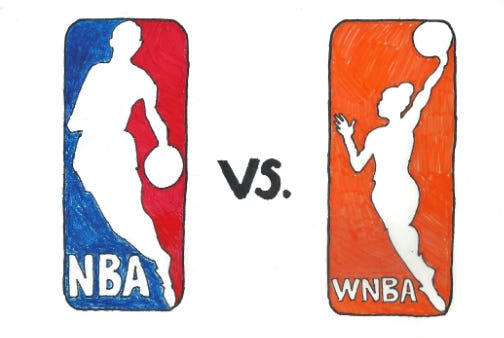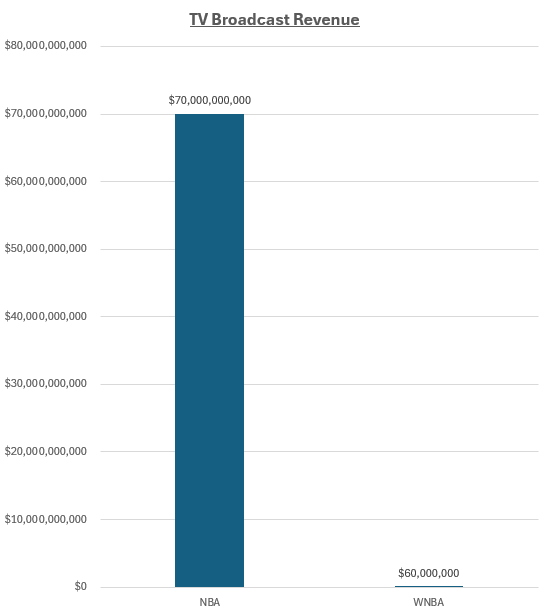Yes, $77,000 is Fair
Caitlin Clark's Salary is Fair; Comparing it to NBA Salaries is Apples and Oranges
Women’s basketball Phenom and star Caitlin Clark was drafted first in the WNBA draft on Monday by the Indiana Fever. Clark has been the impetus to huge interest in Women’s Basketball this year; first by surpassing “Pistol” Pete Maravich’s all time NCAA scoring record1, and then by driving television ratings during March Madness to the point more people were watching her games than watching any of the Men’s.2
Clark’s rookie contract, according to the WNBA pay scale based on the existing collective bargaining agreement? Four years, $338,000, or $76,535 as a rookie.
“OUTRAGE!” Yelled many. “EQUAL PAY WITH THE MEN!” yelled others.
Absurd.
Quickly, without looking it up, name me any five current WNBA players. Or even name me five WNBA TEAMS. If you can do it, good for you, you’re not the reason Caitlin Clark is not getting paid more. If you can’t, congratulations, you represent the overwhelming majority of Americans.
All of this outrage is being driven by the top line number and current fame of Clark3, but in truth it shouldn’t be taken seriously. WNBA players make substantially less for the very simple reason there is less interest in the WNBA than the NBA, and the WNBA makes substantially less money.
Both in the collective bargaining agreements for the NBA and WNBA, salaries and pay scales are based on two major things: 1) ticket sales/prices and 2) Network television ratings and revenue. Long story short, the more people watch and come to games, the more the players get paid. It’s that simple.
The NBA plays 82 games in the regular season and a boatload more in the playoffs that brings in operating revenue of $11 billion annually. The WNBA? A mere $220 million by comparison. The WNBA also plays only 32 games a season; if it would make more money they undoubtedly would expand the season or approve more franchises for the league. You know why they don’t? Because the WNBA actually loses money annually. In fact, it’s heavily subsidized. “By whom?” you might ask? Well, by the NBA.
That’s right, if it weren’t for “the partriarchy” footing the bill, it wouldn’t even exist.
David Stern and the WNBA
The WNBA was created by NBA Commissioner David Stern in 1996, capitalizing on some of the growing Women’s Basketball attention and stars like Rebecca Lobo and Lisa Leslie, and particularly the Women’s Basketball’s Olympic Gold Medal run that same year. The inaugural season consisted of eight teams, that were quickly increased to 16 over the next several seasons. Since then the number of teams has remained the same, but there has been consistent movement as some franchises have moved and others were flat out folded, with new franchises being added soon after to make up for the loss.
In terms of revenue and television ratings, the league since it’s inception has seen minimal growth financially, and flat ratings on networks. TV Network losses through the 2010 season amounted to $400 million for the league. The league has never once made a profit and is currently subsidized by the tune of $10-15 million a year by the NBA. What’s the problem?— female viewership which was always seen as what would drive revenue, has been minimal, and never really materialized. Who does watch? Casual sports fans, who tend to be men, in this case, often with their young daughters; as those girls become teenagers though and watch less with their fathers, both groups tend to stop watching regularly. It turns out that most women don’t watch women’s basketball. By contrast, NBA viewership retains much more consistency across age and interests of the viewers and across every demographic.
Average attendance declined during the 2010s and since 2020 game attendance hovers around 7,000 for the regular season (it varies team to team) and about 9,000 for the post-season. Viewership has been on the rise lately though, with an average audience of about 500,000 per nationally televised game. For comparison, ESPN’s morning show “Get Up” routinely surpasses that amount.
In 2019, the NBA brought in $7 billion in revenue. Part of that was due to the fact there are more teams, playing more games in a season, but it also includes an average attendance of 18k+, 832 sellouts and reaching 98% capacity or more for most games. Yet if the WNBA could replicate what the NBA does in a season as far as generating revenue, they most definitely would extend the seasons and number of franchises. They don’t because they can’t; they have a hard time sustaining the number of games and franchises they currently have, most of which operate at a loss or barely break even.
WNBA Pay/ Apples and Oranges
In the 2023-24 season, the minimum salary for an NBA player exceeded $1 million for the first time. The salary cap, a cap on individual team salaries that is calculated based on the overall NBA attendance, Network rights and anticipated revenues, and based on a formula in the Collective Bargaining Agreement, reached $142 million— that’s per team (across 30 teams, thats $4.26 Billon total to spend on salaries). Disney and TNT are currently in negotiations for the TV rights starting in 2025 in a deal the NBA anticipates worth $60-72 BILLION. With money coming in like that, they can afford to pay the 543 player in the NBA what they do. They can also afford to throw some money toward the WNBA, which they also do.
In 2019, it was reported the WNBA brought in only $60 million in revenue through TV and attendance, of which, based on the collective bargaining agreement, $12.3 million of that was distributed to the players; all the players on all the teams in the league, a little over 100 players total. What does that amount to? A little over $100k per player. Since in both the NBA and WNBA, veteran contracts are worth more than rookie contracts, $77k for a first year player like Caitlin Clark in that regard sounds about right.
What distorts that number are the comparisons to others not in the WNBA, which are frankly incomparable. It’s akin to a person working for a small computer garage start-up comparing his salary to Bill Gates’; it’s just ridiculous to do so in that instance, yet it seems OK to do it in this one. Why? Beats the shit out of me.
Many women point to the gender disparity. In fact, they WANT to point it out as part of a greater argument about gender pay more broadly, the patriarchy or whatnot. My answer to that is when was the last time they watched a WNBA game? If they did, and the ratings were where the NBA’s are, there would be no gender disparity. As it turns out, more people want to watch NBA games rather than WNBA games. That’s what drives the salaries. That’s why Victor Wembanyama makes more as a rookie than Caitlin Clark will.
But let’s take the gender discussion out of it and consider two comparable men’s leagues a second. Ask the starting QB for any of the players in the UFL how much they get paid and whether they should be on the same pay scale as Patrick Mahomes. Mahomes is scheduled to make $58.6 million in 2024. But they’re two separate leagues, with two separate revenue structures, different levels of interest and viewership, and completely different levels of competition. The average UFL viewership in week three this year was 840,000— 66% higher than WNBA viewership. Average league pay: $99k. That’s about on par with the WNBA.
The WNBA did just receive about $75 million in new investment money and half of the teams are now profitable, and interest is also trending in the right direction with many new stars slowly achieving marketability. Clark is expected to be a huge draw nationally, and should drive people to come to games and watch. Still, it’s exceptionally small in comparison to the size and scope of the NBA.
The Caitlin Clark Effect
In any event, the WNBA seems primed for a huge uptick this season. Caitlin Clark is going to be huge draw whenever Indiana is in town to play, and the interest will certainly spark new viewers and fans. The competition will be better (Clark after all is no longer playing against college girls, but rather seasoned veterans), but that may actually bring attention to many of the other quality players in the WNBA. I would anticipate attendance and viewership to increase for games Clark is playing. It will be interesting to see if there is any effect in games in which Clark isn’t playing in. What I mean is, is the draw the WNBA, or is it Caitlin Clark? If the appeal of the WNBA becomes broader, that’s when you know that there is a bigger foothold at work, more WNBA players become known stars and there is a better overall product that people may want to tune in for. If that is the case, guess what? People will watch.
Nonetheless, more people in seats and watching at home means more revenue. More revenue means higher salaries and further investment. More investment means that the league grows and expands and becomes profitable and can stand on its own two feet.
And THAT is what everyone should want.
PurpleAmerica’s Obscure Fact of the Day
Only three of the original eight WNBA teams still remain today in their original home city. Those are The New York Liberty, The Los Angeles Sparks and the Phoenix Mercury. Every other team was either part of an expansion or relocated from somewhere else.
How about another?
The Detroit Pistons were the worst team in the NBA this last year, winning as many games in an 82 game season as the Detroit Lions did in a 17 game season for the NFL—14. What was their average attendance? 18,159. Nearly three times that of the average WNBA team and 15th in the NBA overall.
PurpleAmerica’s Final Word on the Subject
“We Got Next.”
-Original WNBA Slogan from 1997
LIKE WHAT YOU SEE? MAKE SURE TO SUBSCRIBE AND SHARE!!!
Footnotes and Fun Stuff
A couple notes in Maravich’s favor is that he was not allowed to play as a freshman, meaning he set the record in 3 years, and that in his day there was no 3 point shot; a coach once estimated that if there were at the time he would have added another 1000 points to his mark. Nonetheless, times change, records were meant to be broken and Clark now holds the record.
It should also be noted though that Women’s NCAA basketball games during the tournament in which she WASN’T playing had ratings that were notably below the men’s.
Salary aside, nobody should feel bad for Clark. As a college student she made substantial amounts of money on NIL deals, and as a now professional athlete, she’s about to become one of the highest paid sports endorsers out there.










She should have stayed in college for another year!!!
The women's final four this year was incredible. I didn't even watch the mens.